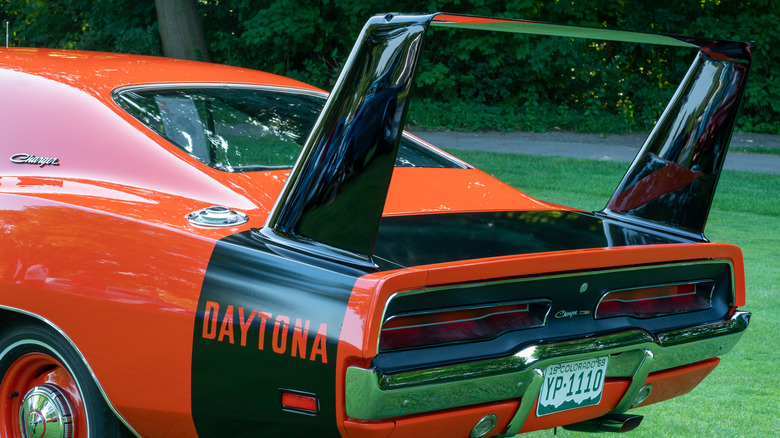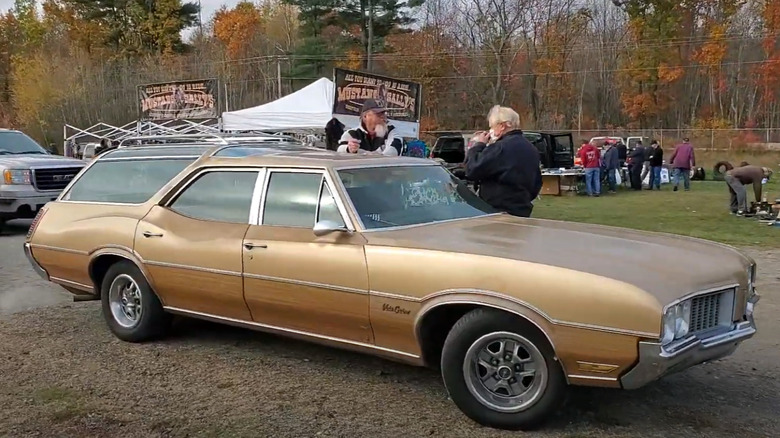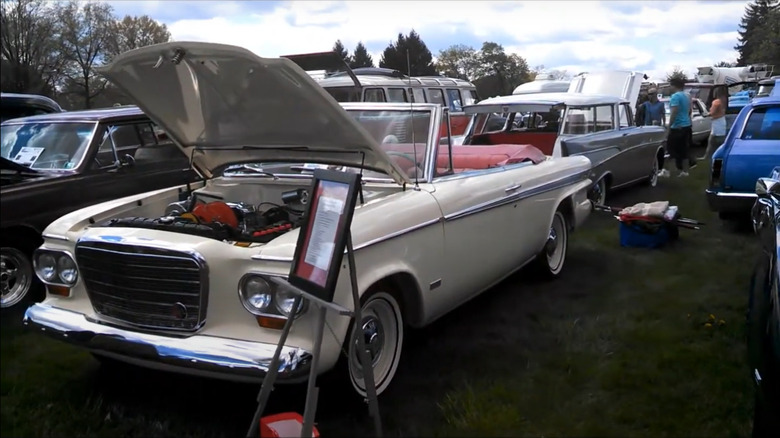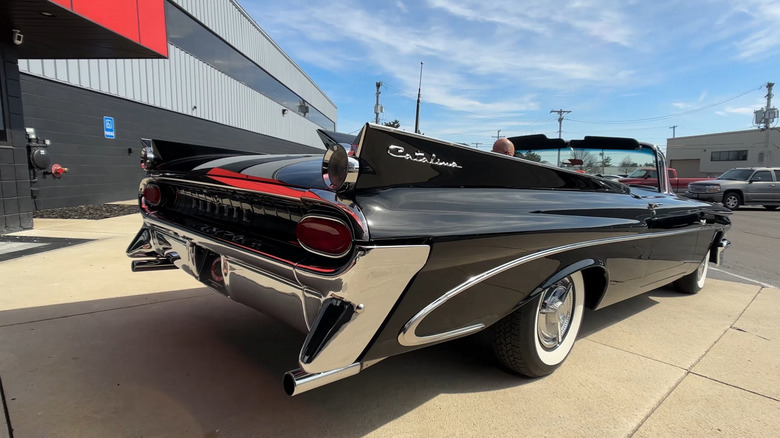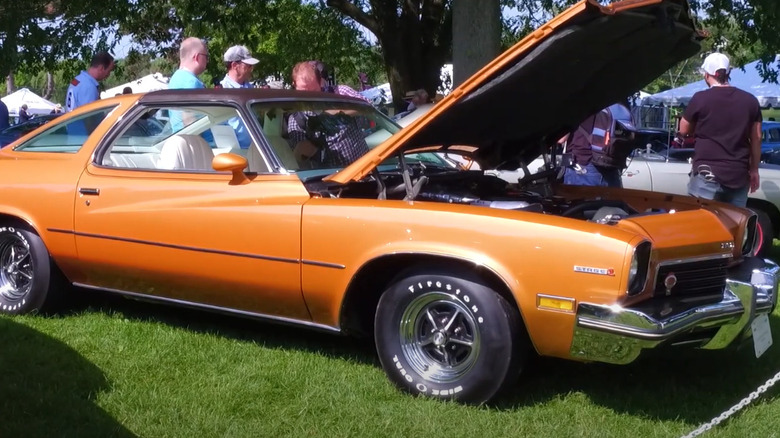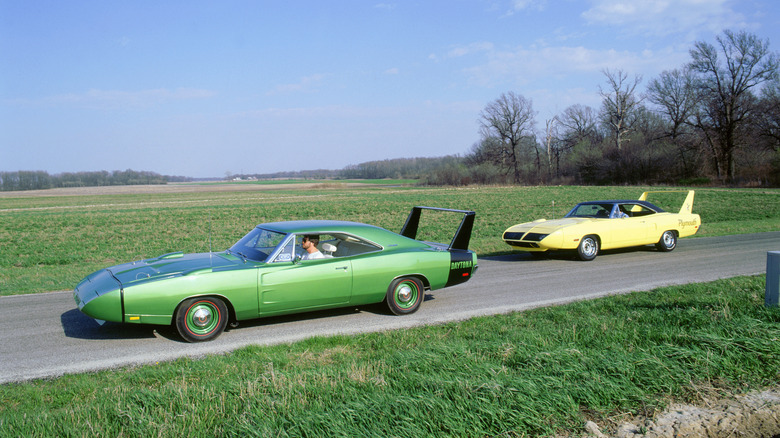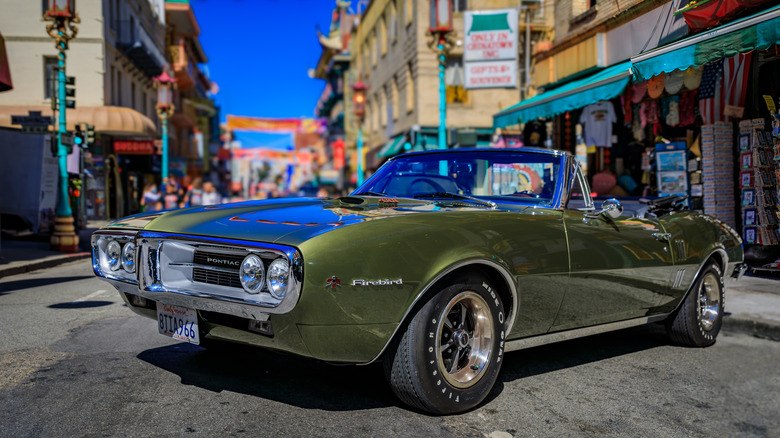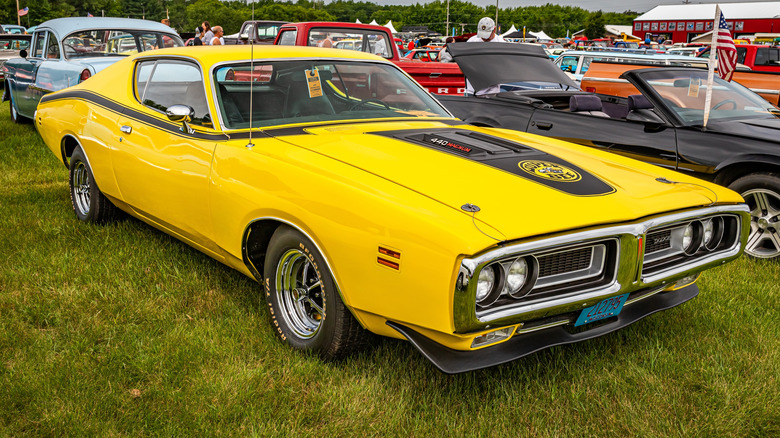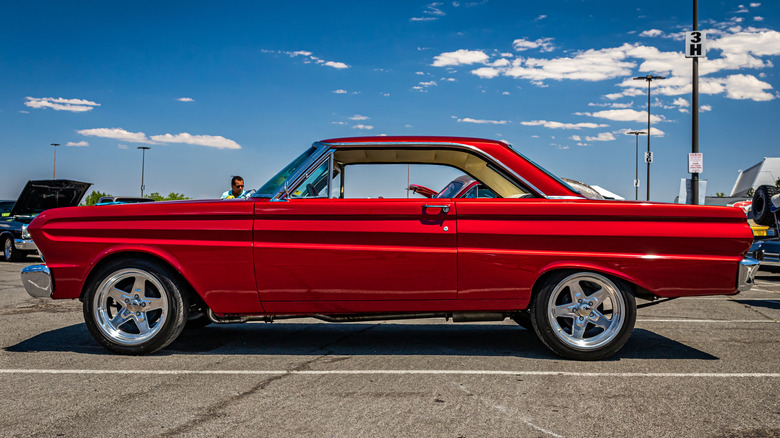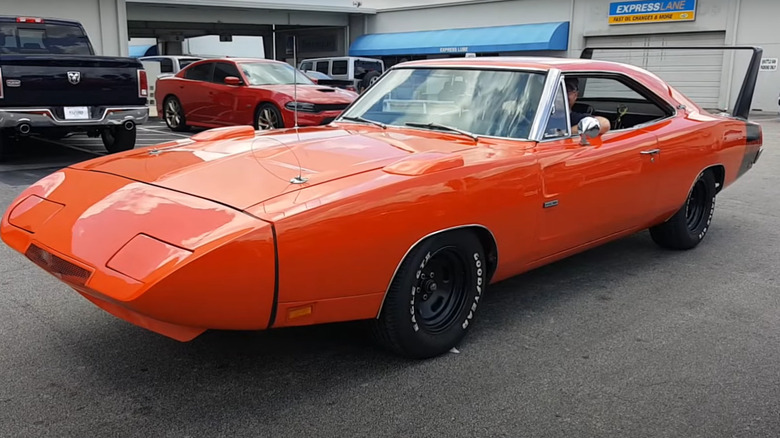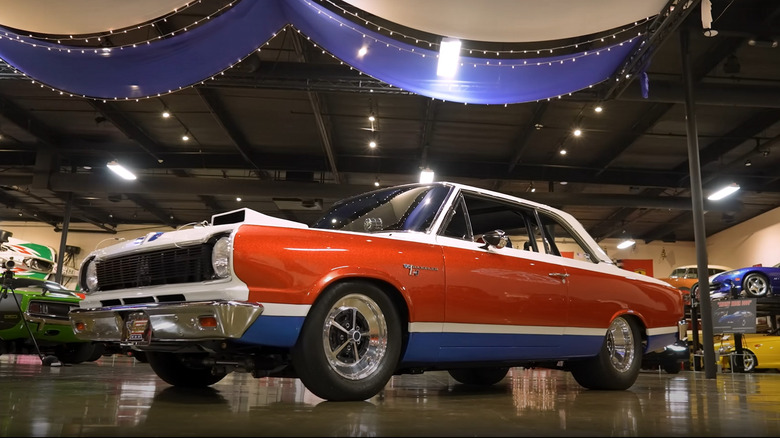10 Of The Strangest Muscle Cars Ever Made
Today, even the tiniest hatchback on the market (looking at you, Fiat 500e) probably comes with more safety features than a fully-equipped 1980 flagship sedan. Back then, manufacturers didn't waste time with airbags, anti-lock brakes, or any of the modern car safety gadgets that we now expect to be standard – crumple zones, proper pillars, curtain airbags, and so on. It was a time when cars — and especially passenger ones — were built by red-blooded American engineers who had in a pretty bog standard blueprint: stuff the biggest engine you can find into the longest chassis possible, add wheels, and see what happens when you mash the accelerator.
Thus, the era of muscle cars was born, and of it came machines that could positively obliterate a quarter-mile drag strip but that needed to do a three-point maneuver to make a right on red. These gorgeous vehicles were almost always gas guzzlers, were inevitably some of the loudest cars ever made, and had the turning circle of a small moon. However, they had charisma, pizzazz, and, most importantly, they had soul. It wasn't just Americans — there were also some unusual cars coming out of Japan at the time as well. However, even in what many consider to be the golden age of automobiles, some oddities were rolling off the production lines, and that's what we're here to show you.
Here are 10 of the strangest muscle cars ever made.
1968 Oldsmobile Vista Cruiser 455
Suppose you were a regular, hardworking American in the late '60s with a caring, happy family to come home to each night. Maybe a dog. You desperately wanted the latest Firebird Trans-Am, but as we know, that one probably wouldn't do for most family-oriented use — and that's where Oldsmobile had you covered. In 1968, they launched the Vista Cruiser 455, which was nothing short of a muscle car wagon. Power for this absolutely gargantuan vehicle came via an equally gargantuan 455 cubic inch (7,456 cc) engine that churned out 390 horsepower and a whopping 500 lb-ft of torque, mated to a three-speed automatic transmission that was actually quite performant.
To show you just how performant it was exactly, here are some figures: zero-to-30 mph in two seconds flat, zero-to-60 mph in 6.2 seconds, and zero-to-100 mph in 16.8 seconds — a time that seems leisurely today, but remember — this was 1968, almost sixty years ago. In addition to those impressive numbers, the Vista Cruiser 455 also managed to reach a top speed of 93.6 mph within the boundaries of a quarter-mile, which it completed in 14.7 seconds from standing. The Vista Cruiser 455 was estimated to have a top speed of 127 mph, and, appreciation where appreciation is due, this hulking land barge could come to a complete stop from 80 mph in a respectable 237 ft — which is just 13 car lengths of itself — pretty impressive.
1962 Studebaker Super Lark
Whenever something is the first of its kind, it tends to be strange, and the 1962 Studebaker Super Lark is no different. Many people consider the Super Lark to be (arguably) the first muscle car ever, and it is definitely the first compact muscle car to hit the markets — and another quirk about it is that at launch, it came with a limited-slip differential, something that wasn't common to begin with, less so in cars at the time. In 1959, Studebaker-Packard was losing money, talent, market share — you name it — and was also struggling against the "big three" muscle car brands in the full-size market.
So what do they do? They become the dominant force in the compact car segment, which is the idea that birthed the Lark, and eventually, the Super Lark. Since the brand was hemorrhaging money, the Lark was built around existing platforms from the mid-50s, and was only 184 inches (4,700 millimeters) at launch, but could still easily seat six, plus luggage. Sales for the lark took off, selling more than 130,000 units in the first year, which is when Studebaker doubled down on the segment with the Avanti, Hawk, and of course, the 1962 Super Lark, all three of which came with the same 289 cubic inch (4,736 cc) V-8 engine, though the Avanti and Super Lark got superchargers. Top speed for the Super Lark was a claimed 132 mph, and zero-to-60 was a respectable 7.3 seconds.
1962 Pontiac Catalina 389 Tri-Power Four-Speed Convertible
The formula for muscle cars around this time was simply to take a massive engine, attach it to an even longer chassis, and you're done. In 1962, Pontiac had their fantastic, hulking V8 ready, but they hadn't yet developed the GTO body to put that engine inside — and they needed something to sell while the GTO was in production. The result of this need was the 1962 Pontiac Catalina 389 Tri-Power Four-Speed Convertible (try saying that three times in a row), and the name really didn't leave much to the imagination. The 389 referred to the 389 cubic-inch (6375 cc) engine that produced an impressive 318 horsepower and 430 lb-ft of torque, "Tri Power" referred to the carburetor setup, and "Four Speed" meant that the engine was mated to a four-speed manual transmission.
The car was 211.6 inches (5,375 millimeters) long, 78.6 inches (1,996 millimeters) wide, but could still reach 60 mph from a standing start in just 6.5 seconds. Other performance figures for the Catalina 389 include zero-to-30 mph in 3.1 seconds, zero-to-100 mph in 17.6 seconds, and an estimated top speed of 134 mph. It could also do the standing quarter-mile in 15.1 seconds, and by the end of the strip, the speedometer would usually hover around the 94 to 95 mph mark — figures that are quite impressive for a car that was six and a half feet wide.
1973 Buick Century Stage 1
Next up is the 1973 Buick Century Stage 1, known colloquially as the "Sun Coupe," a car that posted very high numbers in the year it was launched, being very long, very powerful, very expensive, and so on. The car on our list is a particular version that came with the Gran Coupe body and fitted with the optional 455 engine that was stage one tuned, hence the name. The V8 engine was a monster, coming in at 455 cubic inches (7,456 cc) and churning out 360 horsepower alongside 510 lb-ft of torque — a record for passenger cars at the time, one that would remain in force until the advent of the V10 Dodge Viper some years later.
The Century also came standard with radial tires and disk brakes on the front wheels and was fitted with a three-speed automatic transmission. It could do the standing quarter mile in 16.6 seconds, topping out at a relatively relaxed 83 mph. Given that emissions regulations were breathing down everyone's necks at the time, the performance was also not the best we've seen, with zero-to-30 mph taking 3.3 seconds, zero-to-60 mph coming in at 8.9 seconds, and standing to 100 mph taking a geriatric 25.6 seconds. Add to that the (theoretical) top speed of 123 mph, and it's easy to see why only 728 engines from Buick got the Stage 1 upgrade, and why only 45 Sun Coupe models were ever made.
1970 Plymouth Road Runner Superbird
The 1970 Plymouth Road Runner Superbird was a longitudinal front-engined monster meant to compete with the aforementioned Charger Daytona. Fans might be interested to know that it was the 1970 Plymouth Superbird and not the Charger Daytona that was the inspiration for The King in the "Cars" movie franchise; and in real life, the 1970 Superbird was actually banned from NASCAR racing for a variety of reasons. Anyhow, power for the Superbird came from a 440 cubic inch (7,210 cc) V8 motor that produced 375 horsepower and 480 lb-ft of torque while being paired with a three-speed automatic transmission.
The Superbird could also be optioned with a 390 horsepower version of the same engine but with a six-barrel carb or with the legendary 426 cubic inch (6,980 cc) HEMI engine. The base variant could do zero-to-30 mph in 2.4 seconds, zero-to-60 mph in 5.7 seconds, had a top speed of 125 mph, and could do the quarter mile in 14.3 seconds. Another interesting tidbit is that the scoops on the hood of this car are completely cosmetic on street-legal versions of the Superbird, though in racing variants, they made more space to accommodate beefier racing tires. Sadly, by the time Plymouth managed to sell enough Superbirds to homologate the car into NASCAR, the rules had changed again with limits on carburetors, which is why the Chrysler group abandoned the project within a year of launch.
1968 Pontiac Firebird Ram Air II
About this time, all Pontiacs were getting their backsides handed to them by SS, as well as Mopar's 440 machines — so Pontiac decided to include the available RAM AIR II upgrade on their Firebirds. This pack added different round-port cylinder heads, compression ratios, and a 4.33:1 gear ratio, and only 110 Ram Air II Firebirds were made, which is a shame because they were among the best-looking muscle cars ever made. Of all 1968 Firebirds ever sold, only 98 came with a four-speed, and a mere 12 had an automatic variant.
Power for the '68 Firebird with the Ram Air II upgrade came from a 400 cubic inch (6,555 cc) overhead valve V8 unit that made 340 horsepower and 435 lb-ft of torque, mated to either a three-speed hydra-matic turbo or four-speed close-ratio transmission. Also, rather impressively, the engine was a cast iron unit along with the cylinder heads, meaning that it would last a lifetime if properly cared for. To that end, the Ram Air II Firebird was a rather performant car, with a zero-to-30 mph time of two seconds flat, zero-to-60 mph in 5.1 seconds, and zero-to-100 mph coming in at a retina-detaching 10.9 seconds. The Ram Air II versions had a top speed of just 101 mph — a far cry from the fastest muscle cars of the time — it could still run the standing quarter mile in 13.8 seconds, absolutely demolishing any contemporary challengers.
1969 Dodge Super Bee
People overlook the 1969 Dodge Super Bee because it lived in the shadow of its sister cars, the 1969 Road Runner and the 1970 Road Runner Superbird. This is truly a shame because this weird creation from Dodge that came with the B-body is really the poster child for the muscle car. It was powered by a gigantic 440 cubic inch (7,210 cc) V8 engine that churned out 425 horsepower and 490 lb-ft of torque, paired to either a four-speed manual or a three-speed automatic transmission. This powertrain would rocket the Super Bee to a top speed of 137 mph, with a zero-to-30 mph time of 2.1 seconds, a zero-to-60 mph time of 4.9 seconds, and a breakneck 0-100 mph time of just 12.6 seconds — half a century ago.
The Super Bee would have also been a demon on the drag strip, clocking a standing quarter mile time of 13.5 seconds, at the end of which it would be at 103 mph, making it one of the few cars on our list that could hit 100+ mph in the quarter-mile. Also, if you were opening the bonnet on the A12 body style coupes (of which only 153 got the V8) to access the engine for the first time, you would be surprised to learn that there were no hinges, but instead four telescoping pillars — one at each corner — that lifted the hood up like a warehouse roof.
1964 Ford Falcon Sprint Edition
Don't worry, muscle car aficionados; we haven't forgotten the blue oval company on our list. From Ford, we present to you the 1964 Ford Falcon that shares the same platform as the much-beloved Mustang. In particular, we write about the Sprint Edition trim, as this variant is the one that could hold its own against the other muscle cars of the time as it got a much bigger, beefier engine than the regular variants along with bucket seats, wire-wheel covers, and new badges. For the Sprint, power came from a 260 cubic inch (4,260 cc) V8 stroker engine making 164 horsepower and 258 lb-ft of torque, which delivered this power to the rear wheels via a four-speed manual transmission.
It had a standing quarter-mile time of 17.3 seconds alongside a top speed of 107 mph. Acceleration was fair, with a zero-to-30 mph time of 3.4 seconds, a zero-to-60 mph time of 9.7 seconds, and an absolutely reprehensible zero-to-100 mph time of 39.5 seconds — at that point, when someone asks you your zero-to-100 mph time, you might as well just say "eventually". However, the Falcon was a beauty to look at — especially the hardtop coupe versions — and the paint schemes that it came with were gorgeous, too. Unfortunately, the Falcon Sprint would be shunned by many in favor of the many generations of the Ford Mustang, and production would be halted in 1965.
1969 Dodge Charger Daytona
The second-last item on our list was built to compete in NASCAR, and the silly-looking rear wing quickly became a fan favorite. We're talking, of course, about the 1969 version and not the 2025 Dodge Charger Daytona — a car that hails from an era when NASCAR was actually stock car racing when the race cars were actually based on street versions, and not the other way around. Power came from a 426 cubic inch (6,981 cc) V8 HEMI engine that pushed out 425 horsepower and 490 lb-ft of torque, paired to a four-speed automatic gearbox or a three-speed auto — a setup that would make the Charger Daytona the first NASCAR car to cross the 200 mph boundary — it was clearly a car built to go racing.
And race it did, with a top speed of 137 mph, a quarter mile time of 13.7 seconds, and the ability to hit 103 mph before the end of the quarter-mile strip was up. In addition, it had a zero-to-30 mph time of 2.2 seconds, a standing to 60 mph time of 5.2 seconds, with the zero-to-100 mph mark coming in at a mind-boggling (for the time, anyway) 12.8 seconds. In addition to the HEMI engine, the Charger also came with two versions of the Dodge 440 cubic inch (cc) engine, with one making 375 horsepower and the other making 390 horsepower — it's a shame that we'll never see cars like this again in our lifetime.
1969 AMC Hurst SC/Rambler
Apparently '69 was a good year for being creative (even though AMC got overshadowed by the "big three" brands). The SC/Rambler is by far the most visually arresting car of that year, and that's saying something, given that we just covered the Superbird and Charger Daytona. The SC/Rambler drew its power from a 390 cubic inch (6,384 cc) V8 carb motor that made 315 horsepower and 425 lb-ft of torque, despite which it was an absolute monster on the drag strip, sometimes even wiping the floor with Cobras and Mopars.
To give you an idea of the performance, it boasted a zero-to-30 mph time of 2.4 seconds, a zero-to-60 mph time of 5.7 seconds, and a zero-to-100 mph time of 15.2 seconds, making it one of the quickest cars on this list. In addition, it posted a standing quarter-mile time of 14.3 seconds, at the end of which it would be north of 98 mph, which was almost near its top speed of 106 mph. We should mention that all of these times were bone stock, without any of the aftermarket parts that AMC actually encouraged the owners to use in order to post better times and speeds. Maybe, just maybe, in an alternate timeline, where it wasn't overshadowed by the Mustang, the default muscle car that people think of would have been the Hurst SC/Rambler.
